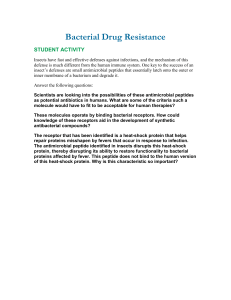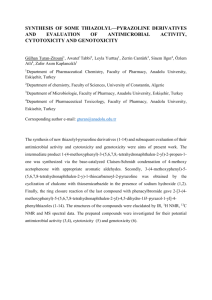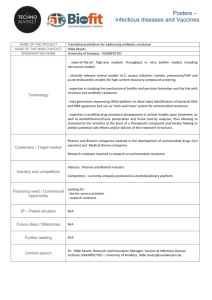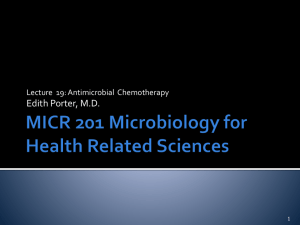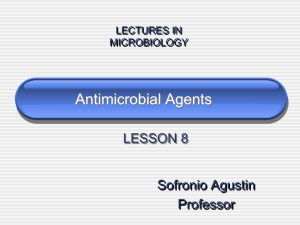Antimicrobial Agents
advertisement
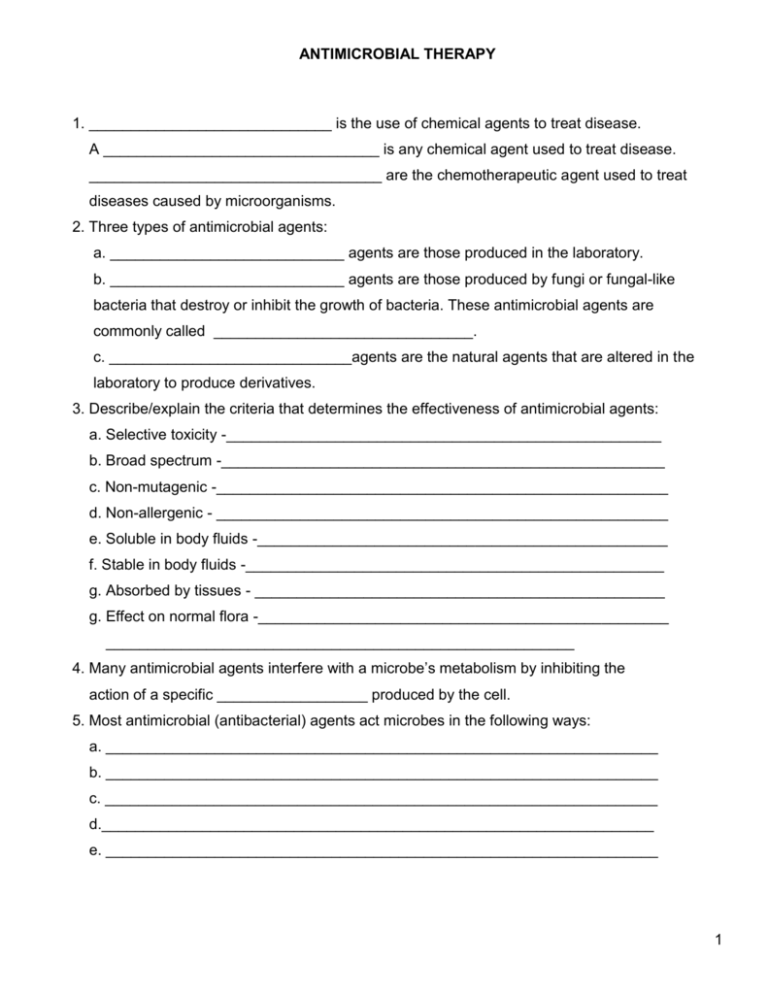
ANTIMICROBIAL THERAPY 1. _____________________________ is the use of chemical agents to treat disease. A _________________________________ is any chemical agent used to treat disease. ___________________________________ are the chemotherapeutic agent used to treat diseases caused by microorganisms. 2. Three types of antimicrobial agents: a. ____________________________ agents are those produced in the laboratory. b. ____________________________ agents are those produced by fungi or fungal-like bacteria that destroy or inhibit the growth of bacteria. These antimicrobial agents are commonly called _______________________________. c. _____________________________agents are the natural agents that are altered in the laboratory to produce derivatives. 3. Describe/explain the criteria that determines the effectiveness of antimicrobial agents: a. Selective toxicity -____________________________________________________ b. Broad spectrum -_____________________________________________________ c. Non-mutagenic -______________________________________________________ d. Non-allergenic - ______________________________________________________ e. Soluble in body fluids -_________________________________________________ f. Stable in body fluids -__________________________________________________ g. Absorbed by tissues - _________________________________________________ g. Effect on normal flora -_________________________________________________ ________________________________________________________ 4. Many antimicrobial agents interfere with a microbe’s metabolism by inhibiting the action of a specific __________________ produced by the cell. 5. Most antimicrobial (antibacterial) agents act microbes in the following ways: a. __________________________________________________________________ b. __________________________________________________________________ c. __________________________________________________________________ d.__________________________________________________________________ e. __________________________________________________________________ 1 6. Describe competitive inhibition: a. The antimicrobial agent must resemble the chemical structure of an essential ______________________ used by the cell for a particular metabolic reaction. b. Because of this similarity in structure the antimicrobial agent reacts with the __________ ____________ on the specific _____________________ catalyzing the reaction. c. This will __________________________ the metabolic reaction. 7. Non-competitive inhibition : The antimicrobial agent directly reacts with/inactivates a specific _____________________. 8. Sulfonamides react by means of competitive inhibition: a. The sulfa drug resembles the structure of ____________________ used by the cell in the synthesis of _______________________. b. The sulfa drug competes with the __________________ for the active site on the ________________ catalyzing the synthesis of folic acid. c. This inhibits the specific ________________ and the synthesis of ____________________. 9. __________________ inhibits the enzyme catalyzing the formation of peptide bonds between the amino acids forming the cross bridges in the synthesis of the compound _________________. This will cause a weakness in the ______________________ resulting in the lysis of the cell. 10. _________________ reacts with a protein in the ribosome (translocase) “freezing” the ________________ onto the _______________. 11. _____________________ reacts with the ribosome to prevent the attachment of the ______________________ to the m-RNA-ribosome. 12. _______________________ reacts with a protein in the ribosome (transferase) preventing the formation of peptide bonds between the amino acids that t-RNA adds to the growing peptide chain. 13. Three ways that antimicrobial agents interfere with nucleic acid synthesis. a. __________________________________________ b. __________________________________________ c. __________________________________________ What is an analogue ? ______________________________________________________ 14. _______________________ inhibits the bacterial enzyme DNA gyrase. ________________________ inhibits the bacterial RNA polymerases. _____________ inhibits the viral enzyme reverse transcriptase. The antiviral agents ________________ and _________________ act as analogues. 2 The antifungal agent _______________________ inhibits RNA polymerases. 15. Describe the structure of polymixin: _________________________________________ ______________________________________________________________________ Polymixins cause disruption of the ________________ when It’s lipid soluble end attaches to the _____________________ in the cell membrane and the water soluble(protein) end attaches to the ____________________________. This causes ___________________ in the cell membrane and the cell looses ______________________________________. 16. List the disadvantages of treatment with antimicrobial agents: a. _______________________________________________ b. _______________________________________________ c. _______________________________________________ d. _______________________________________________ 17. Describe the genetic changes that can result in antibiotic resistance: a. __________________________________________________________________ b. __________________________________________________________________ c. __________________________________________________________________ d. __________________________________________________________________ 18. How may the disadvantages of antimicrobial therapy be avoided? a. __________________________________________________________________ b. __________________________________________________________________ c. __________________________________________________________________ d. __________________________________________________________________ e. __________________________________________________________________ 19. Describe the disk-plate (diffusion) method of antibiotic sensitivity testing in detail: include (a) the procedure, (b) the principle, (c) the observations, (d) how resistant strains may be detected. 3




